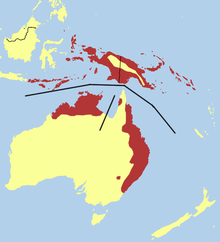Pacific baza
| Pacific baza | |
|---|---|

| |
| Scientific classification | |
| Domain: | Eukaryota |
| Kingdom: | Animalia |
| Phylum: | Chordata |
| Class: | Aves |
| Order: | Accipitriformes |
| Family: | Accipitridae |
| Genus: | Aviceda |
| Species: | A. subcristata
|
| Binomial name | |
| Aviceda subcristata (Gould, 1838)
| |

| |
| Distribution of the Pacific baza. Thick lines demarcate some subspecies, but note that there are actually 13 in total. | |
The Pacific baza (Aviceda subcristata), also known as the crested hawk, crested baza, and Pacific cuckoo-falcon,
Taxonomy
This bird, the African cuckoo-hawk (Aviceda cuculoides), Madagascar cuckoo-hawk (A. madagascariensis), and Jerdon's baza (A. jerdoni), were previously thought to form a species complex.[9]
This hawk has 13 known subspecies:[9]
- Aviceda subcristata bismarckii (Sharpe, 1888)
- A. s. coultasi (Mayr, 1945)
- A. s. gurneyi (E. P. Ramsay, 1882)
- A. s. megala (Stresemann, 1913)
- A. s. obscura (Junge, 1956)
- A. s. pallida (Stresemann, 1913)
- A. s. reinwardtii (Schlegel & S. Müller, 1841)
- A. s. rufa (Schlegel, 1866)
- A. s. stenozona (G. R. Gray, 1858)
- A. s. stresemani (Siebers, 1930)
- A. s. subcristata (Gould, 1838)
- A. s. timorlaoensis (A. B. Meyer, 1893)
- A. s. waigeuensis (Mayr, 1940)
A. s. proxima and robusta have been proposed as subspecies that live in various parts of the Solomon Islands, but these are considered to be the same subspecies as gurneyi.[9]
The genus name, Aviceda, means "bird-killer", combining the Latin words avis, which translates to "bird", and caedere, which translates to "to kill".[10] The specific name, subcristata, combines the Latin words for "somewhat" and "crested", referring to the small crest on the back of its neck.[10][11] This bird was historically most commonly known as the crested hawk, but Pacific baza is now the most frequently-used common name. It is often referred to as "cuckoo-hawk" in Africa and "lizard-hawk" in India.[12]
Description

The Pacific baza is a slender, medium-sized bird, with a slim head and neck.[2] Its appearance is similar to that of other species in its genus. It grows to a total length of 35–46 centimetres (14–18 in), with a wingspan of 80–105 centimetres (31–41 in) and a tail length of 19–23 centimetres (7.5–9.1 in). It weighs 260–450 grams (9.2–15.9 oz), with females being slightly heavier than males. Specimens are typically smaller in the extreme western and eastern parts of its range.[9]
The species have a white underside, which is barred with black. Its upperside is grey, with brown

Females can be distinguished from males by having a slightly browner upperside and sometimes more barring on their
Behaviour
The
The breeding season usually starts in September; in Australia it lasts until February but it can be longer in other countries.[9] During this time, it often soars up and down repeatedly for display and vocalises,[14] positioning its wings in a V-shape when descending. It has also been known to perform various types of somersaults, such as lateral rolls.[11] Its nests are flimsy and composed of sticks, built high in the branches of trees.[2] The species typically lays 1–4 eggs. They have an average size of 4.34 centimetres (1.71 in) in length, 3.51 centimetres (1.38 in) in breadth, and 27 cubic centimetres (1.6 in3) in volume,[16] and are white-coloured with occasional spots.[14] Both males and females incubate them, alternating in average intervals of 1.5 hours.[17] A family studied in 2002 and 2003 had a pre-laying stage period of 16 days, incubation period of 29 days, and nesting period of 35 days. The juveniles became independent from their parents at least 22 days after hatching.[18] The species has a generation length of 7.6 years.[1]
Distribution
The Pacific baza ranges across warmer and more humid parts of the
References
- ^ . Retrieved 19 November 2021.
- ^ a b c d e f "How this Baza bird survived being hit by a car". The Northern Star. 26 September 2016. Retrieved 18 March 2019.
- ^ a b de Lafresnaye, F. (1846). "Mélanges ornithologiques: Sur les genres Aviceda (Swainson), Lophotes (Lesson), Lepidogenys (Gould), et sur deux nouvelles espèces du genre Aviceda". Revue Zoologique. 9: 124–133. BHL page 2362533.
- .
- ^ Gould, John (1837–1838). A synopsis of the birds of Australia and the adjacent islands. London: The author. pl. 46. BHL page 45925292.
- .
- doi:10.1071/mu926222.
- ^ Kaup, J.J. (1847). "Monographien der Genera der Falconidae, Fünfte Monographie". Isis von Oken. 40 (5): 325–386. BHL page 13233820.
- ^ Handbook of the Birds of the World Alive. Barcelona, Spain: Lynx Edicions. Retrieved 14 March 2019.
- ^ ISBN 978-0642278562.
- ^ ISBN 978-0643104365.
- ^ ISBN 0618127623.
- ^ ISBN 978-1486308675.
- ^ ISBN 978-1400865116.
- ^ a b Bell, H. J. (1984). "New or Confirmatory Information on Some Species of New Guinean Birds". Australian Field Ornithology. 10 (7): 209–228.
- .
- ISSN 1448-0107.
- ^ James, Peter (2004). "The breeding cycle of a pair of pacific bazas aviceda subcristata in South-eastern Queensland". Australian Field Ornithology. 21 (4): 133–140.
External links
 Media related to Aviceda subcristata at Wikimedia Commons
Media related to Aviceda subcristata at Wikimedia Commons Data related to Aviceda subcristata at Wikispecies
Data related to Aviceda subcristata at Wikispecies

